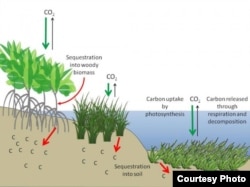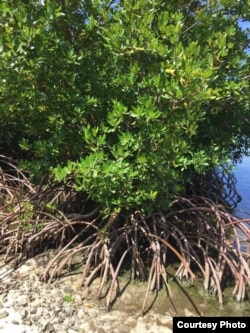When it comes to climate change, there are all kinds of ideas about how to address the problem.
One that has been on the front burner lately is the 'engineering' approach. The idea is: humans can 'fix' the problem through technology, rather than by punishing people and industries that pump carbon into the atmosphere.
Supporting clean energy technologies, and making them as cheap and plentiful as fossil fuels, is one way to engineer our way out of the problem.
But according to a new report, protecting and rebuilding some of our coastal wetlands may be another way to get some carbon out of the atmosphere.
Wetlands as carbon sinks
The new study was done by researchers from the University of Maryland, with support from NOAA, and appears in the Journal Frontiers in Ecology and the Environment. The goal was to find the world's best 'blue carbon' storage sites. Blue carbon is what scientists call the carbon dioxide captured and held in the world's oceans and coastal systems.
VOA spoke with lead author Ariana Sutton-Grier, an ecosystem ecologist at the University of Maryland, about the research. She says one of the main points is that the natural world has already figured out some effective ways to deal with excess carbon. "Coastal wetlands are some of the most productive ecosystems on the planet," she points out, "and they store a lot of carbon below ground."
How much? "The researchers estimated that mangrove forests in the U.S. capture and store as much as 34 metric tons of carbon annually," the team said in a press release. "Which is roughly equivalent to the carbon emitted by 24 million passenger cars in a year."
And that's just the U.S. How about the world? Including the United States, they estimate "coastal wetlands may capture and store more than 200 metric tons of carbon per year globally."
That's a lot of carbon, but Grier admits, not nearly enough to solve the problem. "This would definitely not be a "silver bullet" that would "fix" climate change;" she says. "There is no silver bullet. Human emissions are much larger than natural sinks, but with a problem this big, we need to find multiple solutions to reduce and combat emissions..."
To give you an idea how big, some of the best estimates suggest humans are pumping about 36 billion metric tons of carbon into the atmosphere every year.
To help reverse that trend means protecting, and perhaps beginning to restore the coastlines that have been degraded by human activity and rising sea levels.
Protecting, and rebuilding
That's no easy task. First of all, it's expensive.
Take, as an example, the Coastal Wetlands, Planning, Protection and Restoration Act (CWPPRA), passed by the U.S. Congress in 1990. In the 26 years since it's been put in place, over 200 different projects have been authorized, affecting over 400-thousand hectares of coastal wetland in the state of Louisiana. The annual budget has ranged from 30 to 80 million dollars per year.
It is an expensive, and a time consuming process, but Grier says worth its weight in gold, "if the world invested in coastal restoration in a major way," she says, "then yes, this would 'new' carbon sinks that would be an important contribution to climate change mitigation..."
But it's about more than restoration. Grier says that in the past 250 years, the U.S. has lost about half of its total wetland area. And internationally, she says "...estimates are that we are losing between 0.7% and up to 3% of the global area of these habitats per year."
Not only does that make hurricanes and flooding worse, but all that carbon that was being stored heads into the atmosphere. Grier calls it a double whammy. "In destroying or degrading these wetlands, they get drained and the oxygen in the air causes the carbon in the soil to be decomposed and blown off as CO2 so we lose the store, and what was a fabulous natural carbon sink becomes yet another human-caused emission!"
The question arises: aren't there cheaper ways to save the world's carbon sinks, like the Amazon rainforest? Grier says there's more than one solution, but the researchers "believe that 'blue carbon' habitats may stand alone as the most efficient biological reservoirs of stored carbon on Earth."
And as the world struggles to cut its emissions, restoring wetlands may be a particularly effective way to help meet those targets.










